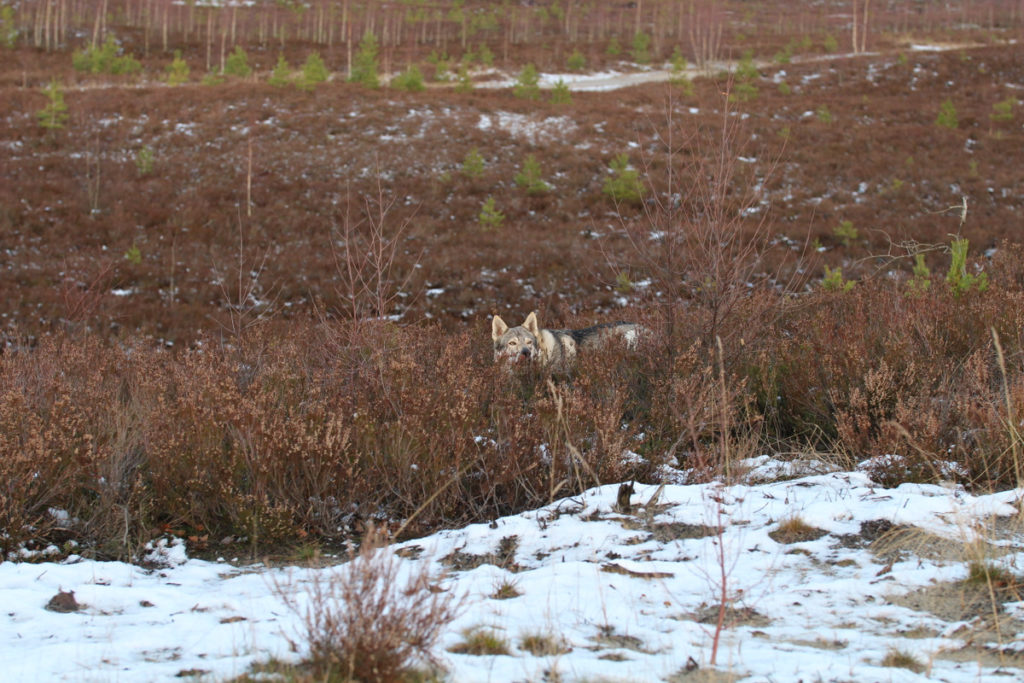
Československý vlčák (Czechoslovakian Wolfdog, patronage: Slovakia) – standard
In 1955, an experiment was started in former Czechoslovakia, namely in the kennel „z Pohraniční stráže“ in Libějovice in southern Bohemia. The aim of the experiment was to find out as much as possible about the behavior of wolves in captivity and also to research the possibility of breeding progenies of a wolf male and a dog female or of a dog male and a wolf female and the viability of those progenies. Another aim of the experiment was to find out whether crossing with wolves can have a beneficial effect on health state, endurance and robustness of dogs used for army service purposes. The first successful mating between a wolf female Brita and a dog male Cézar z Březového háje occurred in spring 1958, and on May 26, five puppies were born. Selected offsprings were then mated again with unrelated German Shepherds.
The experimental crossing was initiated by Mr. Karel Hartl. The breeding then continued in the territory of today´s Czech Republic and also in the territory of today´s Slovakia, where the leading figure of the experiment was Mr. František Rosík. In 1964-1965, first results were published and further aims of the research were established; at the same time, the creation of a new breed was considered. First standard was drawn up by Mr. Karel Hartl in 1966. At that time, four filial generations of offsprings from the first line (Brita – Cézar z Březového háje) and two filial generations of offsprings from a second line (Brita – Kurt z Václavky) existed. The request for registering this new breed and for opening a studbook for the specimens of this breed was, however, rejected because of low number of the specimens.
In 1968, another crossing was made in the kennel in Býchory – this time a wolf male Argo and a German Shepherd female Asta z SNB were used. The second filial generation of this line was also bred there. In 1970, 56 offsprings were in the hands of civil breeders, however, the request for the registration of the breed was again rejected, the same rejection occurred also in 1976.
In 1974, a wolf male Šarik was mated with a bitch from the third filial generation Xela z Pohraniční stráže and also with a bitch of československý vlčák Urta z Pohraniční stráže – this mating was made in a new canine facility near Malacky, owned by the Bratislava brigade of Pohraniční stráž (frontier police) – František Rosík, a co-worker of Karel Hartl, worked in this brigade. At that time, the breeding of the new breed was subdued in the territory of the Czech Republic by a directive of superior authorities; fortunately, the breeding continued in the territory of Slovakia.
In the end of 1981, Český svaz chovatelů (Czech Breeder Association) finally enabled the founding of Klub chovatelů československého vlčáka (Club of Czechoslovakian Wolfdog Breeders) and the registering of litters into a studbook. The Klub chovatelů československého vlčáka was founded in Brno on March 20, 1982. The last crossing with wolves occurred in 1983, when a wolf female Lejdy from ZOO Ohrada in Hluboká nad Vltavou was mated with a German Shepherd male Bojar von Schotterhof. A selected male offspring from this mating – Kazan z Pohraniční stráže – was used several times (starting in 1985) in breeding of československý vlčák. Thus, within 25 years, four wolves participated in the creation of the breed – Brita, Argo, Šarik and Lejdy.
The path to international recognition of the breed started. The standard of československý vlčák was approved by FCI on June 13, 1989 in Helsinki and published by FCI office under No. 332 on April 28, 1994. After splitting of Czechoslovakia, the patronage of the breed was taken over by Slovakia, on the basis of mutual agreement between both succession organizations. After ten years from the approval of the FCI standard, a defence of the breed must have been done, proving the viability of the breed. This defence was carried out by KCHČSV SR and SKJ (Slovak Canine Union), great deal was done by Mr. Štefan Štefík (currently President of SKJ), persuading the opponents of the breed and leading to the definitive recognition of the československý vlčák.
Československý vlčák is classified in FCI Group I. It is a dog of above average size, of a firm constitution, with a rectangular frame. It resembles to wolf in body built, hair, colour and distinctive face mask. It is a lively, very active, docile dog, capable of endurance, with quick reactions.
Československý vlčák dogs show tremendous loyalty towards their masters. They are fearless and courageous, they can be suspicious towards unknown persons, however, they never attack without reason. They are resistant to weather conditions. With regard to their activity, they need a sufficient work – they are versatile, can be used as working dogs (their scenting qualities are widely known), but their training should respect their specific properties.
The breeders of československý ovčák are associated (in former Czechoslovakia, the country of origin of the breed) in Klub chovateľov československého vlčiaka Slovenskej republiky (www.csv.sk) in Slovakia and Klub chovatelů československého vlčáka, o.s. (www.cswolfdog.cz, www.ceskoslovenskyvlcak.cz) in Bohemia and Moravia.